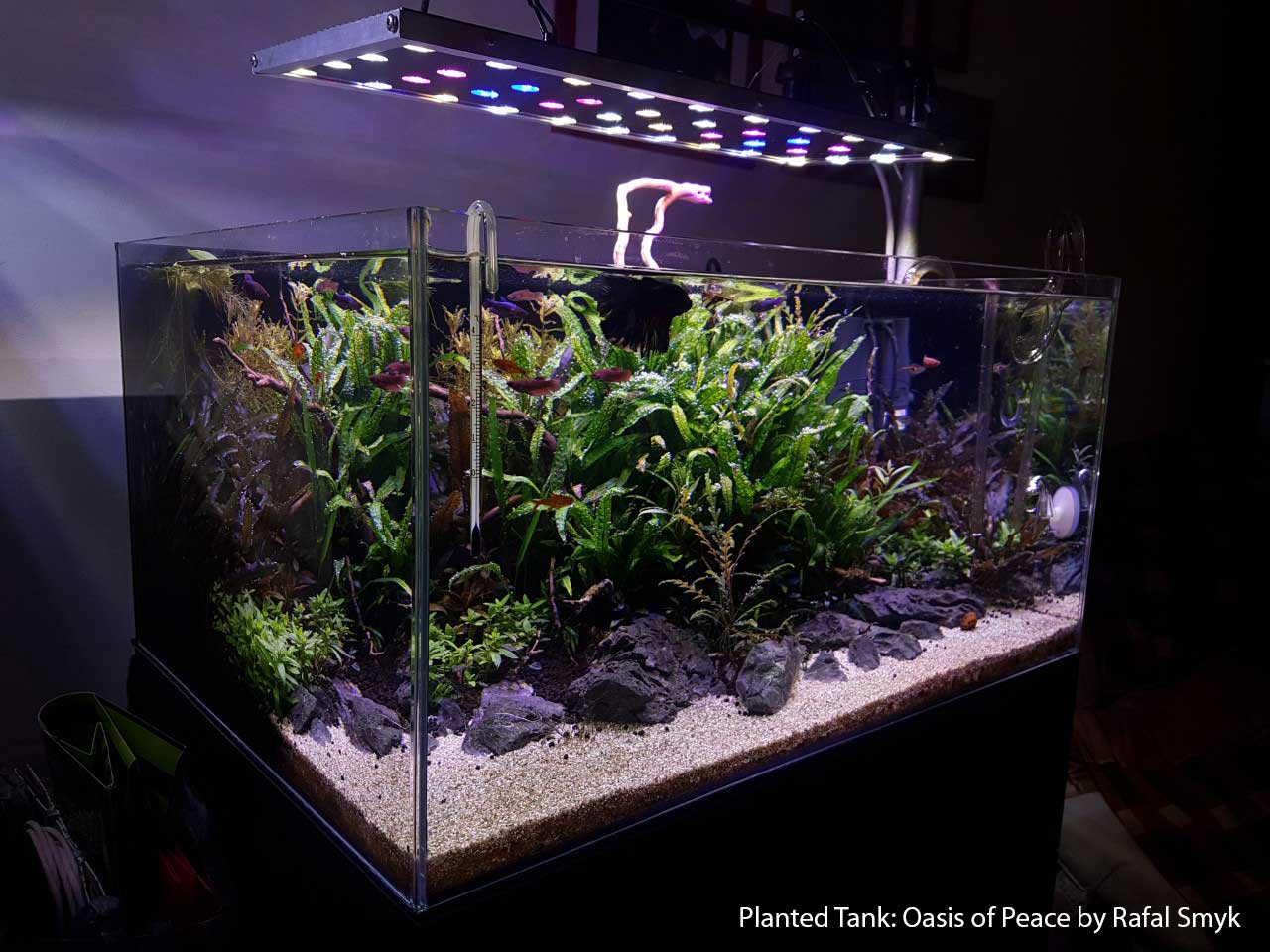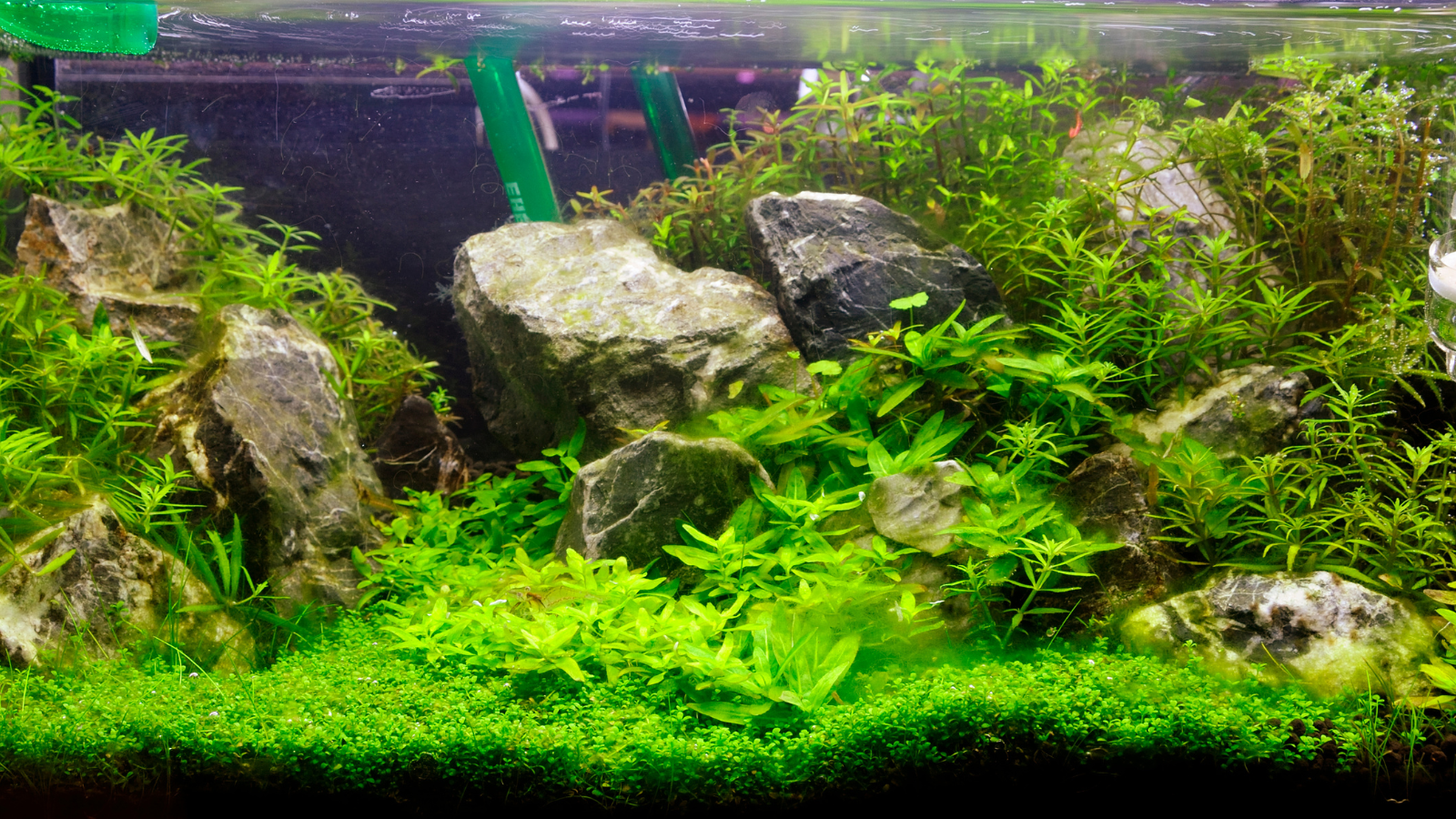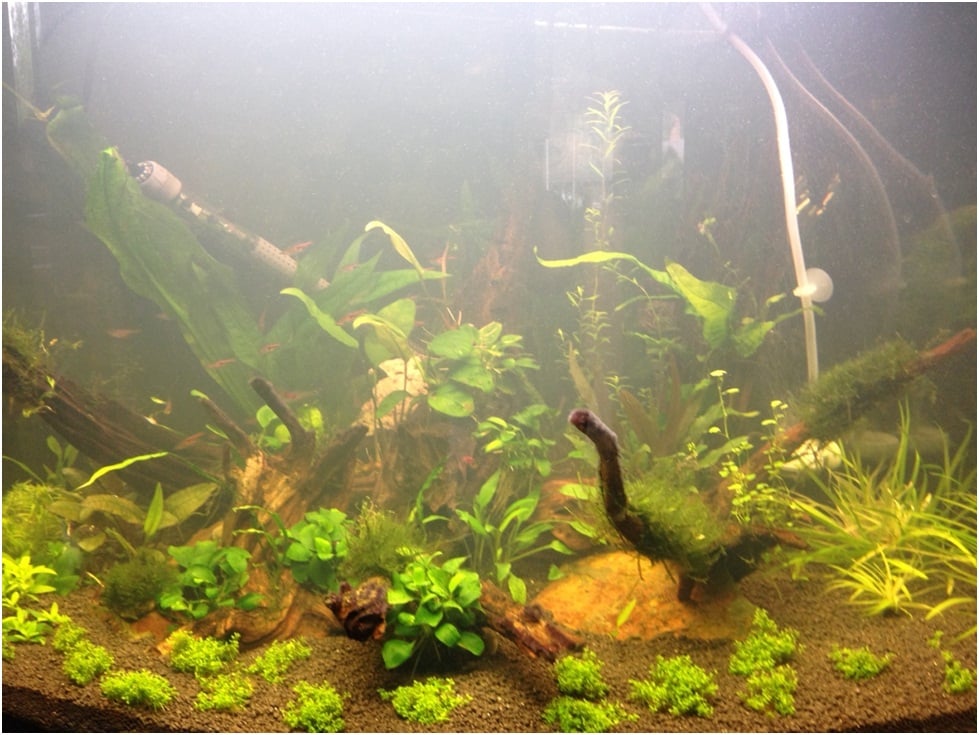
How To Set Up A C02 Enriched Planted Aquarium
In this article we’ll provide a basic template for starting a CO2 enriched planted tank.
We’ll make a couple of assumptions and will address any differences from these assumptions after the main article.
Assumption #1: CO2 injection will primarily be by gas cylinder injection and using a timer solenoid to regulate the injection schedule of the gas.
Assumption #2: This is a new CO2 setup with no fish.
Assumption #3. Fertilization will be by regular dosing of the water column.
First, here’s a shopping list. Some items of the required equipment are a must, while others are optional as noted.
Tank/Stand/Cabinet.
This is obvious, however it should be noted that generally, when choosing a tank size, tanks with a shorter vertical distance (height) are more ergonomic. Remember that planted tanks are hands on. That means you’ll be sticking a hand and arm (or two) in the tank frequently. Tanks that are taller are more difficult to work in unless the hobbyist has long arms. This becomes more critical as the tank volume increases. The tank assembly should be as ergonomic as possible considering the amount of work required to keep it flourishing and beautiful. Pruning, water changing and cleaning should be facilitated as much as possible. Given a choice between two tanks of the same volume, unless other criteria, such as space available or price are more important, then it is typically a better idea to choose the shorter tank over the taller one. If one is considering a tank within an enclosure, access to the tank interior must be given priority.
Substrate.
Any substrate will work in a planted tank. Playsand, gravel, kitty litter, or higher priced “specialist substrate”. There is no need to pay outrageous prices for special plant substrate. Aquatic plants take their nutrition primarily from the water column as well as from the substrate. This does not preclude the use of specialist substrate, only that if assumption #3 is valid then there is a cost savings advantage in avoiding specialist substrates. Most substrates for planted aquariums have one thing in common, that is, they are made of some type of clay. Clay is an excellent substrate for ANY aquarium because clay adsorbs and holds onto toxins, thus helping to maintain water quality. Clay also has the ability to grab nutrients from the aquarium water and to pass those nutrients on to the plant roots. This special ability of clay is always appreciated, but is not essential. Cheap clay products are, for example, Kitty litter, Molar Clay, Akadama, or just about any other Bonsai substrates found at nurseries. Examples of expensive enriched (clay) substrates are: ADA Aquasoil, Oliver Knott Naturesoil, Carribsea EcoComplete and Seachem Flourite. What’s equally important in a substrate is visual appeal as well as tactile feel. In addition to these brand name substrates, there are many substrate “additives” on the market sold at outrageous prices as important soil adjuncts. All of them are completely unnecessary and whatever benefits they might provide are easily obtained for a much lower price by other means.
Filter.
We generally try to adhere as closely as possible to the “10X” rule. This means the filter(s) and pump(s) being used should, together should have the sum of their manufacturers’ throughput (turnover) rating equal to 10 times the tank volume per hour. So, for example, a 125 litre tank should have a filter rated at 1250 litres per hour. This seems excessive at first glance, however, as the plants grow in, they will tend to increasing block flow, which can have the adverse effect of starving the plants of CO2 and nutrition. Again, this is a “rule of thumb”. A 6X or 7X flow rating per hour can also work, but 10X works better. Any type of filter ca be used. Canisters are a popular choice, but sump arrangements, and wet/dry filters are also excellent choices.
Filter Media.
Best not to go overboard with excessive amounts of media. This is because having the filter filled with media throttles the filter throughput, which is much more important than having large amounts of media surface area. Avoid phosphate removers. Activated Carbon, Zeolite, Purigen, bioballs, alfagrog and so forth can be used in moderation. Fill only 50% of the filter capacity or less. Plants are filters, and do a much better job than filters. What plants cannot do is to generate flow or remove detritus.
CO2 gas cylinder.
Pub bottles, CO2 fire extinguisher, Sodastream, Paintball, Disposable Bottle or cylinders from any industrial gas company (such as the British BOC) will all work. The cylinders are equipped with a standard specification valve assembly mounted to the neck of the cylinder, to which the CO2 regulator can be mated. Specialist type bottles, such as paint gun bottles require an adapter.
CO2 Regulator.
The CO2 regulator should have two gauges. One gauge of the CO2 regulator shows the remaining (pressure) content of the cylinder and the other gauge shows the pressure being output to the tank.
Needle Valve.
This valve allows fine control of the gas pressure output to the tank.
Regulator Solenoid.
The solenoid attached to the regulator assembly allows automatic turning on and off of the gas. This is optional, however, it does solve many problems when used with a timer. Having to manually turn the gas on and off every day is a chore best avoided by using the solenoid.
Timers.
Again, optional equipment, but strongly recommended. A minimum of two separate timers is suggested. One timer is attached to the Regulator Solenoid (item 7) and the other timer(s) can be used for the lights. Digital timers are better and are more reliable than analog timers, generally.
Tubing.
Avoid using air line tubing for the CO2. Use only tubing made of material specifically compatible with CO2.
Bubble Counter.
Another optional piece of equipment, but is very useful as a visual indicator of the amount of gas being injected into the tank.
Drop checker.
Another optional piece of equipment which provides a somewhat useful visual indicator of the amount of CO2 dissolved in the tank. It’s called a drop-checker because the pH in the sample water drops as CO2 is added to the tank. So, this device, being filled with water and a few drops of Bromothymol Blue pH indicator allows the hobbyist to “check” how much the pH has “dropped.”
4dKH water and Bromothymol Blue. These are used inside the Dropchecker. Do not use any water other than distilled water adjusted to a KH of 4. This can be prepared at home but requires extreme precision. It’s much easier to buy.
Filter outlet.
This can be the elegant “Lily Pipe” or the less elegant Spraybar. These are important for distributing the filter outlet evenly across the tank. Which one is chosen is an aesthetic choice.
CO2 Diffuser.
Diffusers come in many shapes and sizes. Their function is to dissolve the gas so that it is in an aqueous form. This can be a simple and elegant ceramic disk placed in the tank, or it can be an external device inserted in the filter outlet hose. External devices are referred to as being “Inline” as opposed to being “In-tank”. Inline atomizer generally is more effective than in-tank devices in case of larger tanks.
Hardscape.
Another optional group. This is aesthetic, however, it’s worth pointing out that items such as newly harvested wood will tend to float and will release tannins into the water column for some time, causing discoloration.
Curved Tweezers.
Optional equipment which makes it easier to insert aquatic plants into the substrate without pulling out as the hand is withdrawn.
Fertilizer.
Although name brand liquid fertilizers are convenient and popular, they are generally overpriced. They are all composed of the following ingredients to a greater or lesser extent. Potassium Nitrate (KNO3), Potassium Phosphate (KH2PO4), Urea, Ammonium Nitrate (HN4NO3), trace elements such as Iron, Magnesium, Zinc Manganese and Copper. Cost savings can be realized by simply purchasing these ingredients at bulk prices.
Lighting.
This is intentionally placed at the bottom of the list because most things that go awry in planted tanks occur specifically because most people place it at the top of their list while ignoring the importance of the other items in this list. Most feel a need to “upgrade” the lighting that they already have or which came with the tank when it was purchased. This is usually a huge mistake. High lighting is directly correlated to the appearance of algal blooms, and so more light intensity causes more algal blooms. Avoid high lighting and ignore any advice to use some arbitrary “WPG” value, which almost guarantees that there will be problems with plant health. LED lighting is a popular alternative to T5 and T8 lights, but they are expensive and powerful. If LED is chosen then a dimmer is recommended to control and reduce the intensity.
Having obtained the items on the shopping list, we’re now ready to start. As with any tank there must be foam /Styrofoam or other flexible padding placed between the bottom pane and the mounting surface (unless it’s an old school wire frame stand without a bottom surface). This allows the bottom glass to bend and distort, due to the water load, without restriction. If glass is not permitted to flex it will crack as soon as it’s filled.
Adding substrate and hardscape
The substrate can now be added to whatever depth desired. There is no maximum depth and the minimum depth is determined by root retention considerations. So in areas where the substrate depth is too shallow, it might prove difficult to keep a plant rooted. Hardscape can be positioned. If new/dry wood is being used, it may require some kind of ballast to keep it down for many weeks until it becomes saturated with water.
Planting
It’s best to have as many aquatic plants as possible at the beginning. Most of the more desirable plant species are very expensive, however, one can easily use cheap less desirable plants – and discard later. Fast growing cheap aquatic plants, such as or Egeria, Water Sprite, Hygrophila and so forth should be used as “placeholders” if funds are limited. The reason for this is that aquarium plants develop a symbiotic relationship with the microorganisms in the sediment. The sediment is an area often overlooked when it pertains to filtration, however, there are great numbers of species which contribute to the stability of the tank and the detoxification of the water. Fast growing plants develop root structures which permeate the sediment. Oxygen is then transported down from the leaves to the roots and the gas escapes into the sediment. This oxygen feeds the aerobic bacteria and helps to prevent oxygen starvation and the resultant development of anaerobic bacterial species.
Beneficial bacteria
It’s a good idea at this time to seed the sediment as well as the filter media with detritus from another tank/filter. The reason for this is that mature planted aquariums and filters contain a high population of the desirable aerobic bacterial species. Any LFS or fellow hobbyists will have plenty of detritus and can be gotten for free. There is no need to buy “specialist” bacteria. If there is a forest, garden or house plant nearby, simply dig up a few handfuls of dirt in close proximity to the roots of the wild, garden plant or house plant and mix it in with the tank substrate and filter media. The same bacterial species will be available at no charge.
Remember that it is not necessary to use all sediment to fill a deep space if funds are limited. Objects such as foam blocks can be used to bulk up areas or to provide platforms for hardscape mounting, then covered with substrate to give the illusion of deep sediment. A popular method is to fill ladies nylon stockings with kitty litter. The “leg” can then be formed into any shape and used as a platform. Slopes can be held in place with simple pieces of plastic to act as retaining walls so that over time, the slope does not flatten out due to gravity and water flow.
If there are many plants to insert, be sure to have a spray bottle hand filled with water. Periodically spray the plants to keep them moist, otherwise the will dry out and become damaged.
Generally, it’s better to have a slope to the sediment, higher in the back than in the front. Slopes can also be made left to right. This gives depth to the layout as the scape will visually “flatten out” when viewing the scene under water. Avoid too many large and thick hardscape pieces as they will tend to give a bulky, cluttered look to the scape and they will also block flow/distribution. The current trend is to use thinner animated root wood which has a more dramatic appeal.
Tall, bulky or otherwise fast growing plants should be planted in the background. Slower growing plants should be placed in the mid-ground and smaller carpet plants should be placed in front (be aware that carpeting plants are not easy to maintain so CO2 injection will be needed). For better arrangement effect it's worth adding some red plants.
Mosses, Anubias and ferns should be ties or glued to hardscape and should NOT be inserted into the sediment, otherwise they will rot. Superglue Gel Type can be used with mosses that naturally cling to surfaces, as well as the standard fishing line. Large rocks or wood always look more interesting when covered in moss.
Time for water
Having placed hardscape and inserted the plants, the tank can be then be filled. A common tactic is to cover the planted surfaces with lots of crumpled newspaper and to place a saucer on the substrate. The newspaper acts as a shock absorber against the movement of the water against the plants so that they do not become dislodged. Fill with a hose onto the saucer so as not to disturb the substrate. This helps also to minimize the cloudiness. After filling, carefully remove the newspaper and saucer.
It would be better to leave the lights off and allow the plants to settle in until the following day. Being flooded is trauma for plants. It requires several weeks to make the adjustments from being a land plant (which is the way they were grown at the nursery) to being an aquatic plant. Too many people blast the newly planted tank with a lot of light. The plants are not able to use the light properly and are damaged by it. To make the adjustments, plants now need to deal with the problem of gas exchange. The two important gases are CO2 and Oxygen. While the lights are off proceed to the next step which requires some experimentation. This is best done with the lights OFF.
CO2 injection
If assumption #2 is correct and there are no fish in the tank then, with the lights off and assuming the regulator/needle valve assembly is mounted to a full cylinder and all the tubing is connected to the diffuser, open the cylinder valve by turning it counterclockwise. The 1st gauge will show a high pressure. Then open the needle valve, also counterclockwise, until a steady stream of bubbles appear in the bubble counter. The second gauge will show a much lower pressure such as 1 Bar or 2 Bar. Measure the pH of the aquarium water. The goal, generally, is to have a bubble rate that causes the pH to drop by about 1 unit within 1 hour. Continue to monitor the pH frequently to determine the trend. Computer savvy hobbyists can use MS Excel or equivalent to plot graphs showing the trend. At some point, if the injection rate is steady, the pH will bottom out and the pH will not drop any further. However long it takes to drop the pH by 1 unit, note this amount of time required. This amount of time is how much in advance the gas must be turned on PRIOR to the lights turning on. Set you timer for the solenoid and the timer for the lights according to this measurement.
So, for example, suppose at the selected bubble rate, it requires 1.5 hours to drop the pH by 1 unit. Assume that your target time for lights on is 8AM. If so then the timer for the gas solenoid should be set to open at 6:30AM and the timer for the lights should be set to energize at 8AM. By 8AM the Dropchecker should be a lime green color.
This is not necessarily the end of the story. Continue to monitor the pH. It may be that the injection rate is too high for the fauna. If the pH drops much more than the 1 unit target, the needle valve may need to be closed slightly and the timer adjusted to account for the lower injection rate (i.e. gas turned on earlier to allow more time to saturate the water with gas). This is an iterative process that requires strict attention to detail because CO2 is toxic to fauna if dosed in too high amounts and if under-dosed, will result in starvation of the plants.
The 1 pH unit drop target is another “rule of thumb”. Each tank is different and it may require more of a drop or less of a drop depending on the alkalinity of the water. In highly alkaline water, large amounts of dissolved CO2 only produces small pH drops because of the alkaline buffers present in the water. In water that is soft, small amounts of dissolved CO2 causes large drops in pH. So in alkaline water, it’s possible to overdose CO2 if the drop is too great and in soft water is easy to under-dose if the pH drop is not great enough.
Do not turn the lights on until the approximate targets are reached. Fine tuning can be accomplished with the system running but when lights are on the plant responds to both the light and the CO2, therefore this can disrupt their system. When lights are off they are in standby mode and are not affected by changes in the gas.
All tanks with co2 injection require large amounts of nutrition. Many folks claim this is not true because they do not add fertilizers and yet their plants do well. The explanation for this is that their water supply is laced with nutrient products and/or they are using a substrate fortified with nutrients. Nutrition is covered under a separate guide.
It is best if no fish are not added until 6-8 weeks has elapsed. The first reason for this delay is that the tank chemistry is not stable due to the low bacterial load and toxic chemical are produced which can damage the sensitive gills of fish. This can either kill fish outright or can damage them so that in the future, their tolerance for upsets is significantly reduced and they perish later for seemingly unknown reasons. Patience is key here.
High tech tanks require much more cleaning and water changes than non-enriched tanks. Plats produce huge amounts of organic waste such as oils, proteins and carbohydrates which leach from the leaves. These organic waste product poison the water for both plants and fish. Poor water change practices will usually be accompanied by a slow decline in overall tank health, which includes a higher probability of algal blooms.
For the first 6-8 weeks it is suggested that a 50% (or more) water change 2X or even 3X per week be accomplished. Thereafter, a 50% (or more) water change once a week is adequate.
If the tank is illuminated by multiple sets of lights, it’s recommended that 50% of the light be disabled for the first 6-8 weeks. Thereafter, turn 50% of the lights on at the scheduled time and after several hours, turn the remaining lights on.
Trimming should be accomplished regularly to clear the flow/distribution pathways and to encourage more bushy growth. As the tank matures heavier trimming will be required.
If cheaper, unwanted aquarium plants were used, they can be discarded after about 6-8 weeks ad replaced by more desirable plants. When uprooting plants or when cleaning the substrate, it should always immediately precede a large water change. The sediment is a repository for toxic Nitrogen products and disturbed sediment can spew these products into the water column which can trigger algal blooms in your planted aquarium.



